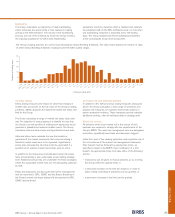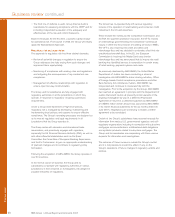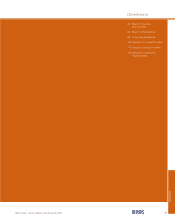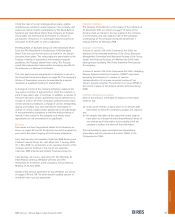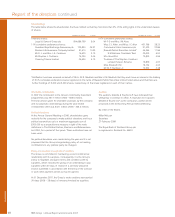RBS 2007 Annual Report Download - page 90
Download and view the complete annual report
Please find page 90 of the 2007 RBS annual report below. You can navigate through the pages in the report by either clicking on the pages listed below, or by using the keyword search tool below to find specific information within the annual report.
RBS Group • Annual Report and Accounts 2007
88
Business review continued
Business review
Pension obligation risk
The Group is also exposed to risk from its defined benefit
pension schemes. The schemes’ assets comprise investment
portfolios which are held to meet projected liabilities to the
scheme members. Risk arises from the schemes because
returns from these portfolios may be less than expected and
because there may be greater than expected increases in the
estimated value of the schemes’ liabilities. In these
circumstances, the Group could be obliged, or may choose, to
make additional contributions to the schemes.
Equity risk
Non-trading equity positions can result in changes in the
Group’s non-trading income and reserves arising from
changes in equity prices/income. These movements may
crystallise during the course of normal business activities or in
stress market conditions.
There are several reasons for retaining equity positions in the
Group’s non-trading book, including achieving strategic
objectives, expected capital gain and supporting venture
capital transactions. These investments are carried at fair value
with changes in fair value recorded in profit or loss, or in equity.
The types, nature and amounts of exchange-traded exposures,
private equity exposures, and other exposures vary significantly.
Such exposures may take the form of listed and unlisted equity
shares, equity warrants and options, linked equity fund
investments, private equity and venture capital investments,
preference shares classified as equity and capital stock in the
Federal Home Loans Bank and the Federal Reserve Bank.
Insurance risk
The Group is exposed to insurance risk, either directly through
its businesses or through using insurance as a tool to reduce
other risk exposures.
Effectively, an insurance contract transfers risk from the
policyholder to the insurer, whereby, in return for a premium
paid, the insurer indemnifies the policyholder on the
occurrence of specified events. Insurance risk arises through
fluctuations in the timing, frequency and/or severity of insured
events, relative to the expectations at the time of underwriting.
Insurance risk is managed in four distinct ways:
•Underwriting and pricing risk
•Claims management risk
•Reinsurance risk
•Reserving risk
Overall, insurance risk is predictable, supported by large
volumes of data over time. Uncertainty does exist, especially
around predictions, for example, variations in weather. Risk is
minimised through the application of documented risk policies,
coupled with governance frameworks.
The specific characteristics of each of the risks highlighted
above are as follows:
Underwriting and pricing risk: the Group manages underwriting
and pricing risk through a wide range of processes which
include:
•Underwriting guidelines that detail the class, nature and type
of business that may be accepted;
•Pricing policies which are set by senior management;
•Centralised control of policy wordings and any subsequent
changes.
Claims management risk: arises if claims are handled or paid
inappropriately. Claims are managed using a range of IT
system controls and manual processes conducted by
experienced staff. These, together with a range of detailed
policies and procedures, ensure that claims are handled in a
timely, appropriate and accurate manner. The processes
include controls to avoid claims staff handling or paying claims
beyond their level of authority, as well as controls to avoid
paying invalid claims. Loss adjustors are used to handle
certain claims to conclusion.
Reinsurance risk: the following types of reinsurance are used
to protect against the impact of major catastrophic events or
unforeseen volumes of (or adverse trends in) large individual
claims and to transfer risk that is outside the Group’s current
risk appetite. Reinsurance of risks above the Group’s risk
appetite is only effective if the reinsurance premium payable
makes economic sense and the counterparty is financially
secure. Before entering a contract with a new reinsurer, it must
satisfy the Credit Risk Approval process that uses information
derived internally and from security ratings agencies.
Acceptable reinsurers are rated at A- or better unless
specifically authorised by the RBS Insurance Group Board.
•Excess of loss ‘per individual risk’ reinsurance to protect
against significantly large individual losses.
•Excess of loss catastrophic ‘event’ reinsurance to protect
against major events, for example, windstorms or floods.
•Quota share reinsurance to protect against unforeseen
adverse trends, where the reinsurer takes an agreed
percentage of premiums and claims.
Other forms of reinsurance may also be utilised, subject to
approval by senior management.
Reserving risk: arises when reserves are assessed incorrectly,
so that insufficient funds are retained to pay (or handle) claims
as they fall due either for claims which have already occurred
in relation to the claims reserves (including claims handling
expense reserves) or will occur in future periods of insurance









